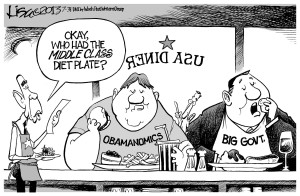We’ve been hearing a lot lately about the disappearing middle class, primarily in campaign speeches by candidates for president.
Hillary Clinton has begun using the term “everyday Americans,” most likely because she doesn’t want to spell out who she classifies as middle class. She’s not alone. Most candidates do not want to define how they determine middle class income because it depends on so many factors, and you can be thought of as “out of touch” if you float an income range as middle class.
Determining whether you are middle class comes down to self-identity. “The middle class label is as much about aspirations among Americans as it is about economics,” wrote Patricia Cohen, “but a perspective that was once characterized by comfort and optimism has increasingly been overlaid with stress and anxiety.”
In a recent Pew Survey, half of those Americans surveyed described themselves as middle class, while 29 percent described themselves as middle class. Eleven percent considered themselves upper middle class. Economics columnist Robert Samuelson recently viewed those in the middle class as fearing a disconnect between their aspirations and opportunities.
Just 21 percent of those surveyed in a recent NBC/Wall Street Journal poll believe their children would live better than they have.
Earnings usually define an individual’s position, but it depends where you are living. While someone making $65,000 in Cedar Rapids, Iowa could be considered in the middle class, someone living in Los Angeles would need to be paid three times that to be considered middle class.
In the mid-fifties, the middle class was divided into two groups – upper and lower. Those in the upper middle class were generally better educated professionals in salaried positions, while the lower middle class was made up of skilled craftsmen and semi-professionals in lower-level management.
Clinton tells her followers that the deck is stacked against them and that she intends to be their champion, fighting for higher wages, overtime pay and childcare.
If you consider where the government spends our money, it’s easy to see that the middle class has been dealt a pretty good hand as two-thirds of the budget goes for “payments to individuals” – Social Security, Medicare and Medicaid, food stamps, student loans, etc.
President Obama chooses to ignore these benefits when he talks about the few who are doing better and better while everybody else is treading water. But even the liberal Brookings Institution takes issue with his remark as it referred to the “net impact on income of government taxes and non-cash transfers like food stamps and health insurance, which benefit the poor and middle class much more than richer households.”
The Brookings report concluded that “the incomes of the bottom fifth of households actually increased by 26 percent … (while) the middle fifth increased by 37 percent,” and stated “There is no disappearing middle class, nor can household income, even at the bottom, be characterized as stagnant, let alone declining.”
I’d like to think our GOP presidential candidates are prepared to respond to those who challenge them with the phony claim of the disappearing middle class.






